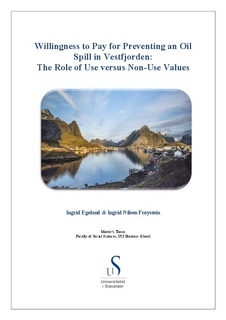| dc.contributor.advisor | Kipperberg, Gorm | |
| dc.contributor.author | Frøystein, Ingrid Nilsen | |
| dc.contributor.author | Egeland, Ingrid | |
| dc.date.accessioned | 2016-09-30T08:01:36Z | |
| dc.date.available | 2016-09-30T08:01:36Z | |
| dc.date.issued | 2016-06-14 | |
| dc.identifier.uri | http://hdl.handle.net/11250/2412129 | |
| dc.description | Master's thesis in Economic analysis | nb_NO |
| dc.description.abstract | In this study the values that could be lost if an environmental damage occurs in Vestfjorden are estimated. The overall research question is: “What is the willingness to pay for preventing an oil spill in Vestfjorden?”. The idea is that this might give indications on how people value the region’s environment and their current economic and recreational use of it. Focus is further on identifying the use and non-use components of the potential losses. In other words, a goal is to learn what parts of these that are related to use of the Vestfjorden area and not.
The Contingent Valuation Method is applied in order to investigate this. The data is taken from an Internet administered survey conducted in 2013, for which a sample from the Norwegian population was stratified on county level. The respondents were asked if they were willing or not to pay a proposed sum of money to avoid a constructed environmental damage in Vestfjorden. There were questions concerning recreational usage of the area, and others to detect various potential effects on the subject in focus.
Average annual willingness to pay per household in a 10-year period is estimated to be between 1304 and 1359 NOK. Total values that could be lost if an environmental damage occurred in the Vestfjorden area is calculated at 28.6 billion NOK. There is a high degree of uncertainty surrounding these numbers. The non-use component makes up the largest part of the potential losses. This means that many Norwegians who are not defined as users of the area want to pay for preserving it. The result indicates that Vestfjorden is of national importance. Various demographic and other variables seem to affect how individuals value the region.
The study was planned and implemented according to recommendations for the Contingent Valuation Method. Most of the explanatory variables that are included in the analyses have the expected estimated coefficients. The value estimates resembles the ones found in other researches. Together, this indicates that the results from the study are reliable and valid. | nb_NO |
| dc.language.iso | eng | nb_NO |
| dc.publisher | University of Stavanger, Norway | nb_NO |
| dc.relation.ispartofseries | Masteroppgave/UIS-SV-HH/2016; | |
| dc.rights | Navngivelse 3.0 Norge | * |
| dc.rights.uri | http://creativecommons.org/licenses/by/3.0/no/ | * |
| dc.subject | økonomi | nb_NO |
| dc.subject | administrasjon | nb_NO |
| dc.subject | økonomisk analyse | nb_NO |
| dc.subject | miljøøkonomi | nb_NO |
| dc.title | Willingness to Pay for Preventing an Oil Spill in Vestfjorden: The Role of Use versus Non-Use Values | nb_NO |
| dc.type | Master thesis | nb_NO |
| dc.subject.nsi | VDP::Social science: 200::Economics: 210::Economics: 212 | nb_NO |

